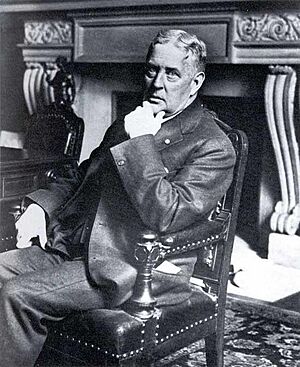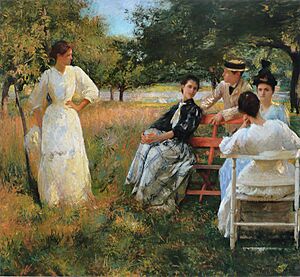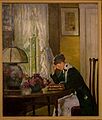Edmund C. Tarbell facts for kids
Quick facts for kids
Edmund C. Tarbell
|
|
|---|---|

Tarbell, c. 1919
|
|
| Born | April 26, 1862 |
| Died | August 1, 1938 (aged 76) |
| Education | School of the Museum of Fine Arts, Boston |
| Known for | Impressionism, Painting |
| Movement | Ten American Painters |
Edmund Charles Tarbell (April 26, 1862 – August 1, 1938) was an important American Impressionist painter. He was a member of the famous group called the Ten American Painters. His artwork is displayed in many top museums. These include the Boston Museum of Fine Arts and the Metropolitan Museum of Art. He was also a main leader of a group of artists known as the Boston School.
Contents
Growing Up and Learning Art
Edmund C. Tarbell was born in West Groton, Massachusetts. His father passed away in 1863 from typhoid fever while serving in the Civil War. Young "Ned," as he was called, and his older sister, Nellie, were raised by their grandparents.
As a teenager, Tarbell took art classes in the evenings. He also worked as an apprentice at a printing company in Boston. In 1879, he started studying at the School of the Museum of Fine Arts, Boston. He was in the same class as Robert Lewis Reid and Frank Weston Benson. These two artists would later join him in the Ten American Painters group.
Tarbell was encouraged to study art in Paris, France. At that time, Paris was the center of the art world. In 1883, he went to the Académie Julian art school. There, he learned from famous teachers. In Paris, he copied paintings by Old Masters at the Louvre museum. He also saw the exciting new Impressionist art style. Both of these influences shaped his own artwork. He also traveled to Italy, Belgium, and Germany to see more art.
Tarbell returned to Boston in 1886. He began his career as an illustrator, a private art teacher, and a portrait painter.
Family Life
Two years after coming back to Boston, Tarbell married Emeline Arnold Souther. She was an art student from a well-known family. Tarbell often painted his family members. He used his wife, their four children (Josephine, Mercie, Mary, and Edmund Arnold), and later his grandchildren as models. His paintings often show scenes from their daily lives.
While teaching at the Museum School in Boston, Tarbell and his family lived in Dorchester. In 1905, they bought a summer home in New Castle, New Hampshire. This house was on an island by the Atlantic coast. Tarbell built his studio right by the Piscataqua River. From his studio, he could sketch sailboats passing by.
Tarbell loved collecting old American furniture and art. He would arrange these items with Chinese ceramics and Japanese prints in his studio. These items often appeared in his paintings. The Tarbells eventually moved to New Castle permanently.
Art Career
In 1889, Tarbell became a teacher at the Museum School, taking over from his old mentor. He was a very popular teacher. He taught his students strong art basics. His students included Bertha Coolidge and Lilian Westcott Hale. His teaching style was so influential that his students were sometimes called "The Tarbellites."
However, in 1912, there was a disagreement at the Museum School. Tarbell and his friend Frank W. Benson resigned from their teaching jobs. In 1914, with help from painter Lilla Cabot Perry, they opened The Guild of Boston Artists. This group aimed to support artists in the city. Tarbell was its first president until 1924.
In 1918, Tarbell became the principal of the art school at the Corcoran Gallery of Art in Washington, D.C.. He held this job until 1926. The Museum of Fine Arts later asked him to return as an advisor. He helped oversee the building of the school's new art building.
Famous Paintings
His 1891 painting, In the Orchard, made him famous as an artist. It shows his wife and her siblings relaxing outdoors. Tarbell became known for his beautiful, colorful paintings of people in landscapes. Later, his work showed the influence of Johannes Vermeer, a 17th-century Dutch painter. In these paintings, Tarbell often showed people in elegant old-fashioned rooms. He carefully studied light and shadows in these works.
Tarbell painted portraits of many important people. These included industrialist Henry Clay Frick and U.S. presidents Woodrow Wilson, Calvin Coolidge, and Herbert Hoover. His art was even part of the painting event at the 1932 Summer Olympics.
Awards and Lasting Impact
- Tarbell won many art awards and medals throughout his career.
- He received an honorary doctorate from Dartmouth College in 1929.
- He helped judge painting competitions at major exhibitions in 1904, 1915, and 1926.
- In 1906, he became a full member of the National Academy of Design.
- He was also made a fellow of the American Academy of Arts and Sciences in 1927.
When he passed away, his obituary in The Boston Traveler newspaper said: "Great American Painter Dies." It praised his honest work and said his paintings would continue to speak to the world for centuries.
Images for kids










